



|
In the Harry Pollard Papers at the Wichita State University Libraries' Department of Special Collections are several hundred of the photographs shot during production by Universal Films' publicity personnel. You can see 51 of those pictures here, chosen for the way they illustrate several stories: the one the movie set out to tell, the ones that for various reasons it didn't tell. The story the film tells revolves around Eliza. There may have been various reasons for this emphasis, too, not least the fact that Margarita Fischer, who played Eliza, was married to Harry Pollard. These first four stills were probably taken not just for publicity purposes, but also to test some of the costumes Fischer wore in the film. The first three were taken by "Freulich," and the last one by "Walter Fredrick Seely, Los Angeles, California." When viewers first see Eliza, she's wearing the wedding gown (far left). When she runs from the Shelbys' she's warmly dressed for winter. But at each successive stage of her journey, as various men pursue and enslave her, she wears less. The center photos show her costume in the sequence shot on the riverboat, where Loker and Marks hold her captive, and the outfit she's wearing far right is the way she's dressed through the final scenes, after Legree has bought her and taken her to his sinister plantation. Universal used this last photo in several publicity pieces (see ARTICLES AND NOTICES). |
 |
 |
 |
 |
|
The Pollard Papers include the following five photos of the film being made. Margarita Fischer — in and out of costume — is in all of them:
|
 |
 |
 |
 |
 |
|
One of the points Universal's publicity repeated made was how faithful Pollard's script was to Stowe's novel, but in fact the story was radically changed in order to keep Eliza at its center. She does escape across the ice, but is then recaptured and carried south by Marks and Loker (on the same boat Haley and Tom are on). The dramatic climax with which the movie's first part ends occurs when Marks and Loker sell Harry. When Eliza realizes what is happening, she puts up a spirited but futile fight to recover him. That sequence is represented by the 8 images below, in which you can see how aggressive Fischer's Eliza is. There is no scene, for example, of George defending his family with a gun at the Rocky Pass; throughout the film he sneaks and hides. Eliza, on the other hand, picks up Loker's whip and uses it on him, though she cannot prevent Harry from being taken away: |
 |
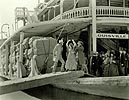 |
 |
 |
 |
 |
 |
 |
|
There is no Emmeline in the movie. Her place is taken by Eliza, who is bought by Simon Legree at the same auction in which he buys Tom. Thus even at Legree's, the perils of Eliza remain the focus of the film as scripted and shot. Her character became even more prominent after Universal decided to make deep cuts in the film on the basis of mixed reviews and lackluster ticket sales in its opening run in New York. It was shortened from 13 reels to 10, though few scenes with Eliza in them were eliminated. The deepest cuts seem to have been in the section set at the St. Clares, including the two scenes represented by the 3 photos below, of Eva with her mother, and with Tom: |
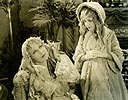 |
 |
 |
| Most of Topsy's scenes were also cut, including the sequence photographed below, showing how the movie introduced Topsy into the St. Clare household, and how her "wickedness" upset not just Ophelia, but also the routine established by Adolphe and the other "genteel" house slaves: |
 |
 |
 |
 |
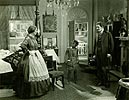 |
 |
 |
 |
 |
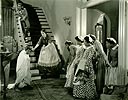 |
|
The movie's opening scenes were also cut to increase the emphasis on Eliza and George, the "whitest" of the slaves at the Shelbys'. The first group of stills below show how Pollard originally filmed at least two scenes inside Tom's cabin. The first (far left), in which Tom wears a dress coat, establishes his happy home life. The remaining two are probably from the sequence in which that happiness is destroyed by the news that Tom has been sold: |
 |
 |
 |
|
Although the final cut does include a scene of the Shelby slaves at work before the wedding of Eliza and George, and at play afterwards in the quarters, celebrating the wedding with dancing that mimics, in minstrel fashion, the elegant dancing of the whites in the big house, a number of other scenes of these slaves were cut, including a revival meeting and baptism led by Tom, as you can see below: |
 |
 |
 |
 |
 |
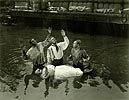 |
|
Other eliminated scenes featuring slaves are represented in the 3 photos below. The first two are probably also from the Shelby portion of movie: the little girl on the make-believe auction block is same as youngest child in Tom's cabin, and the decor of big house much plainer than scenes we have of St. Clare mansion in New Orleans. The third image (far right) is part of the sequence set on the steamboat, where Eva meets Tom as part of the gang that Haley is taking south. In the film's final version of that scene, however, this very expressive image was cut: |
 |
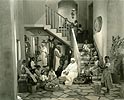 |
 |
|
There seems to be a pattern to these cuts. At the same time that they bring forward Eliza's suffering at the hands of white men like Loker, Marks and Legree, they also eliminate much of the representation of slavery itself as an institution, and effectively erase much of the film's representation of blackness. If you look again, for example, at the two shots above of the cast and crew at the beginning and end of the filming, you can see how difficult it is to find any black faces in the pictures. (There seems to be one in the picture at the Shelby set, barely visible above the camera lens.) Given the segegrated nature even of America's entertainment industry in the 1920s, the absence of blacks in these photos isn't surprising, but it also points to the story the rest of these still images help us see: the way the film, in its efforts to appeal to white movie-goers, carefully controlled the representation of non-white characters. Pollard and his crew did go to a lot of trouble to create air of authenticity. Some of their efforts are entirely specious, like hanging Spanish moss on Kentucky trees growing in Southern California. But there are also several fine indications of the historic research they did into slavery itself. For example, in the two images below, note the posters hanging on the two walls, the first in the tavern by the Ohio River where Eliza seeks refuge, the second in the auction house where she is sold to Legree. Both of these scenes were left in the movie, and the posters go into detail about how runaways were hunted down, and how young children were sold at auction — though of course the film's viewers couldn't have read them: |
 |
 |
|
We can't actually say for sure when every scene represented in these various photos was eliminated from the film, whether in the original editing, or in the cuts made after the movie opened. With the sequence below, however, we know that the erasure was made before the film's premiere. Originally the film opened with an auction scene set "in the early forties," showing how the Shelbys acquired Eliza as a young girl when she and her mother were sold apart. In this version, her mother is Cassy, who is bought by Simon Legree — thus setting up the family reunion that occurs at the film's end, when Eliza and Tom are in turn bought by Legree. The SOUVENIR PROGRAM that Universal sold to movie-goers describes this scene in detail, but the movie-goers themselves never saw it. When Universal tested the movie on focus groups made up of white Southerners, they objected to it strongly enough to convince the studio to eliminate it, and to begin instead with the wedding festivities at the Shelbys', "whose gentle rule of the slaves," according to one of the film's first captions, "was typical of the South." The 3 photos below give us an idea of how the original opening looked. In the last image (far right) Cassy is being driven away as the young Eliza reaches out to her, while Mr. and Mrs. Shelby approach: |
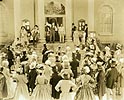 |
 |
 |
|
Three final photos give us access to three other images movie-goers didn't get to see, this time from the movie's concluding episodes. Below left: the movie's set for the slave quarters at Legree's; the scenes in the Shelby quarters were abridged, but the scenes in the Legree quarters were entirely eliminated. Center: a close-up of Tom during the scene of his final, fatal beating by Legree, Sambo and Quimbo. New York reviewers commented on how graphic this scene was, and it was one of the first sections to be re-edited; in the final version, Tom's body is hidden behind a post throughout the beating. Right: the final version of the film ends conclusively enough, with Eliza, George and Harry reunited in front of Legree's house, after the Union Army has arrived to free the slaves and Legree himself has fallen to his death, but apparently the script called for at least one further shot, of Eliza and her husband at the head of a column of emancipated slaves, as seen here. Like so many other images that featured black faces, this image was cut. |
 |
 |
 |
